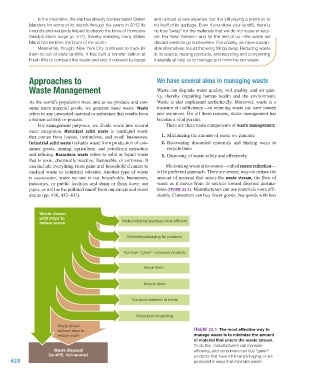Page 629 - Environment: The Science Behind the Stories
P. 629
In the meantime, the site has already compensated Staten and railroad at less expense, but it is still paying a premium to
Islanders for some of its stench through the years; in 2012 its rid itself of its garbage. Even if you close your landfill, there is
mounds and wetlands helped to absorb the force of Hurricane no true “away” for the materials that we do not reuse or recy-
Sandy’s storm surge (p. 517), thereby shielding many Staten cle. For New Yorkers—and for the rest of us—the waste we
Island homes from the brunt of the storm. discard needs to go somewhere. Fortunately, we have sustain-
Meanwhile, though, New York City continues to truck its able alternatives to just throwing things away. Reducing waste
trash to out-of-state landfills. It has built a transfer station at at its source, reusing products, and recycling and composting
Fresh Kills to compact the waste and ship it outward by barge materials all help us to manage and minimize our waste.
Approaches to We have several aims in managing waste
Waste Management Waste can degrade water quality, soil quality, and air qual-
ity, thereby impairing human health and the environment.
As the world’s population rises, and as we produce and con- Waste is also unpleasant aesthetically. Moreover, waste is a
sume more material goods, we generate more waste. Waste measure of inefficiency—so reducing waste can save money
refers to any unwanted material or substance that results from and resources. For all these reasons, waste management has
a human activity or process. become a vital pursuit.
For management purposes, we divide waste into several There are three main components of waste management:
main categories. Municipal solid waste is nonliquid waste
that comes from homes, institutions, and small businesses. 1. Minimizing the amount of waste we generate
Industrial solid waste includes waste from production of con- 2. Recovering discarded materials and finding ways to
sumer goods, mining, agriculture, and petroleum extraction recycle them
and refining. Hazardous waste refers to solid or liquid waste 3. Disposing of waste safely and effectively
that is toxic, chemically reactive, flammable, or corrosive. It
can include everything from paint and household cleaners to Minimizing waste at its source—called source reduction—
medical waste to industrial solvents. Another type of waste is the preferred approach. There are several ways to reduce the
is wastewater, water we use in our households, businesses, amount of material that enters the waste stream, the flow of
industries, or public facilities and drain or flush down our waste as it moves from its sources toward disposal destina-
pipes, as well as the polluted runoff from our streets and storm tions (FIGURE 22.1). Manufacturers can use materials more effi-
drains (pp. 430, 432–433). ciently. Consumers can buy fewer goods, buy goods with less
Waste stream
with steps to
reduce waste Make industrial practices more efficient
Minimize packaging for products
Purchase “green” consumer products
Reuse items
Recycle items
Compost materials at home
Municipal composting
Waste stream
without steps to FIGURE 22.1 The most effective way to
reduce waste manage waste is to minimize the amount
of material that enters the waste stream.
To do this, manufacturers can increase
Waste disposal efficiency, and consumers can buy “green”
(landfill, incinerator) products that have minimal packaging or are
628 produced in ways that minimize waste.
M22_WITH7428_05_SE_C22.indd 628 13/12/14 2:25 PM

